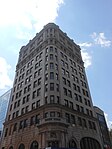Eldridge Street Synagogue
1887 establishments in New York (state)19th-century architecture in the United StatesHistory museums in New York CityJewish museums in New York CityLower East Side ... and 15 more
Moorish Revival architecture in New York CityMoorish Revival synagoguesMuseums in ManhattanNational Historic Landmarks in ManhattanNew York City Designated Landmarks in ManhattanOrthodox synagogues in New York CityProperties of religious function on the National Register of Historic Places in ManhattanRussian-Jewish culture in New York CitySociety museums in New York (state)Synagogue buildings with domesSynagogues completed in 1887Synagogues in ManhattanSynagogues on the National Register of Historic Places in New York CitySynagogues preserved as museumsUse mdy dates from March 2014

The Eldridge Street Synagogue is a synagogue and National Historic Landmark in Chinatown, Manhattan, New York City. Built in 1887, it is one of the first synagogues erected in the United States by Eastern European Jews. The Orthodox congregation that constructed the synagogue moved into the downstairs beth midrash in the 1950s, and the main sanctuary was unused until the 1980s, when it was restored to become the Museum at Eldridge Street.
Excerpt from the Wikipedia article Eldridge Street Synagogue (License: CC BY-SA 3.0, Authors, Images).Eldridge Street Synagogue
Eldridge Street, New York Manhattan
Geographical coordinates (GPS) Address External links Nearby Places Show on map
Geographical coordinates (GPS)
| Latitude | Longitude |
|---|---|
| N 40.71475 ° | E -73.993472222222 ° |
Address
Museum at Eldridge Street
Eldridge Street 12
10002 New York, Manhattan
New York, United States
Open on Google Maps




